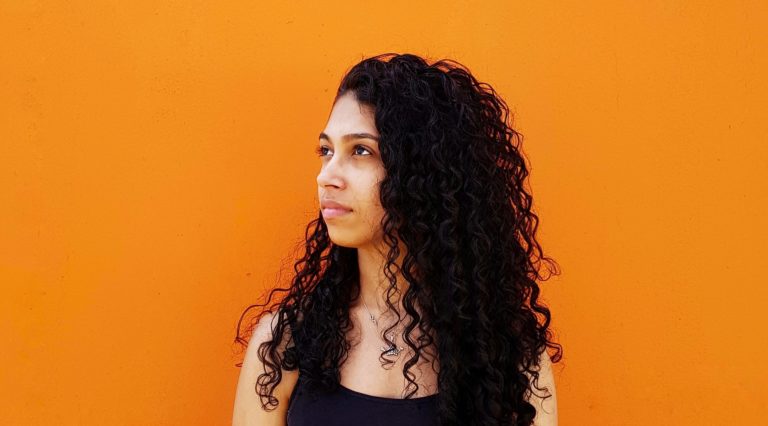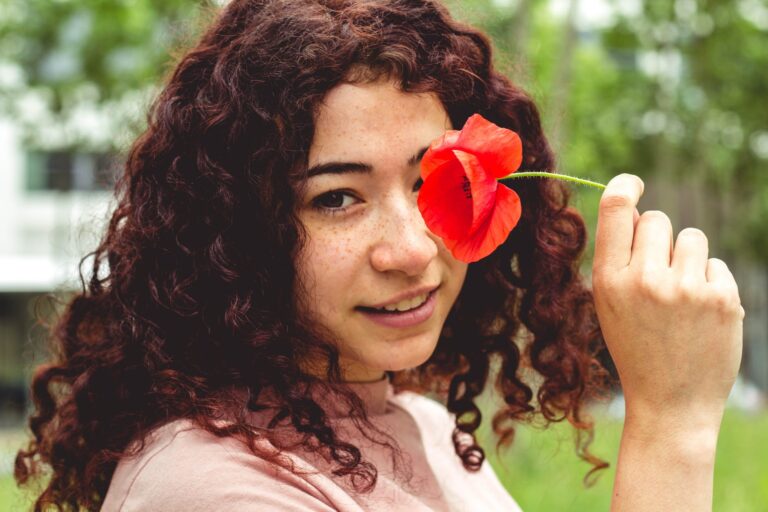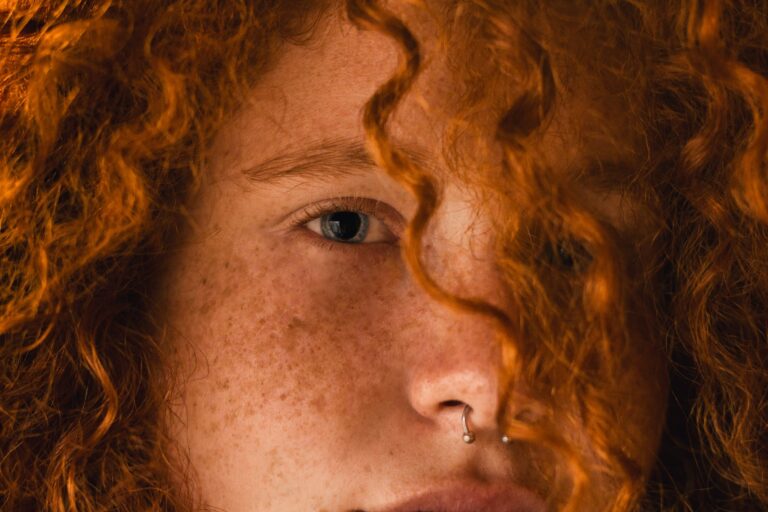Dry Scalp and the Curly Girl Method

One of my biggest struggles with the Curly Girl Method hasn’t been my hair at all–it’s been my scalp.
I’ve always had a flaky scalp. In my pre-Curly Girl days, I used Head and Shoulders shampoo a couple of times a week to keep (what I thought was) dandruff under control.
When I started the Curly Girl Method, one of my concerns was how I would manage my scalp issues. However, I’d read that a lot of people find the Curly Girl Method helps their scalp, which made me even more excited to give it a shot.
As you may have guessed, the Curly Girl Method didn’t fix my scalp–at least not at first. After some research, I realized I didn’t have dandruff at all. I had dry scalp, which isn’t the same thing.
And while the Curly Girl method didn’t initially fix my scalp problems, it did ultimately help me develop a natural, gentler, more effective way of dealing with it.
Today, I’m going to tell you about my experience with dry scalp and five possible solutions to help you combat it if you find yourself in the same position.
Side note: This page does contain affiliate links, which means if you purchase something using the product links on this page, I may get a small commission. This comes at no extra cost to you and helps keep this site running. Thank you!
My Dry Scalp Experience
The first clue that I had dry scalp came during my transition period.
Most Curly Girls have a phase during their transition period when they first start following the Method where their hair is oily. That’s because your hair is used to overproducing oil to replace the oil stripped out regularly with a sulfate shampoo.
But my hair never got all that oily. This was likely because of my dry scalp.
A few months into the Curly Girl Method, I started noticing some serious flakes on my shoulders and dry patches at various points on my scalp. The flakes would fall pretty much any time I shifted my hair or moved my head too fast.
At the time, I thought this was dandruff and I set off to find a dandruff solution.
But what I learned along the way is that Dandruff is an overproduction of oil, and dry scalp is an underproduction of oil. They are two different problems.
Given that I had white flaky patches of dry skin on my scalp, I was fairly confident I had dry scalp, and I set out to treat it as such.
This was a self-diagnosis on my part, but given that my flakes have gone away, I’m pretty sure I got it right!
With that in mind, here are five natural, Curly Girl Approved solutions to help you fix your dry scalp.
Five Possible fixes
Oil
Putting some moisturizing oils on your scalp will help keep your scalp moisturized and keep flakes at bay. I found my way to this approach by accident.
Remember how I said I didn’t have a problem until a few months into the Curly Girl Method? Well, that’s because I had been massaging my scalp with oils to help it grow, which inadvertently kept my scalp moisturized.
I’ve found a mix of 50% melted coconut oil and 50% olive oil have been the most effective. I massage the oils into my scalp about an hour before bed a few nights a week.
Then I let the oils stay in my hair overnight, then wash them out with my co-wash in the morning.
I don’t like to sleep in a shower cap, so I find that if I make sure the oils just coat my scalp, an hour is enough time for them to absorb enough that my pillow and hair don’t end up oily.
When the problem was worse, I did this nightly, then backed off as my flakes died down. This has had the biggest impact in hydrating my scalp.
Shampoo more
If you’re only washing every 5-7 days, shampooing with a sulfate free shampoo, like Shea Moisture’s Curl and Shine, more often may help. This does two things to help with dry scalp.
First, it helps to remove any dry patches that have flaked off so they’re not trapped in your hair.
Second, it helps remove product build up, which can gather on the scalp and lead to more flaking/dryness.
However, it’s worth noting that you don’t want to be shampooing too much more, as that may remove too much oil and leave your scalp dryer. (I know, the balancing act can kind of suck sometimes!)
So if you’re already shampooing 2-3 times a week, this suggestion may not be best for you.

Use a scalp relief sulfate free shampoo
If shampooing more often isn’t getting it done, you may want to think about trying a shampoo designed to help your scalp.
And yes, there are curly girl approved, sulfate free options, you can choose, like Maple Holistics Pure Tea Tree Oil Shampoo or Cantu’s TXTR Scalp Relief Shampoo.
The Cantu shampoos turned out to be a GAME CHANGER for me. If you want to read more about it, check out my full review here!
Use a scalp brush when you wash/cowash
This also turned out to be pretty helpful for me. Using this inexpensive shampoo/scalp brush when I wash and cowash.
It helps make sure there isn’t any product/conditioner build up on the scalp. It also helps remove dry, dead skin in the shower so it won’t flake off onto your shirt.
If you want to level up, you can also try this vibrating scalp massager.
Exfoliate your scalp
This suggestion doesn’t help dry scalp as much as it helps cut down on the flakes dry scalp causes. Your scalp is skin. It has dead skin cells just like the rest of your body.
And if you have dry scalp, it’s likely that you have more dead skin cells than usual. Exfoliating can help get rid of excess flakes and dead skin that may be contributing to any dry patches.
To exfoliate, you can use a specifically designed product, like this scalp scrub from Not Your Mother’s, which is Curly Girl approved.
Or you can make your own exfoliator with a tablespoon of brown sugar and a tablespoon of conditioner.
See a medical professional if necessary
If nothing you’re trying is working, consider reaching out to a doctor or dermatologist. Healthy hair starts with a healthy scalp, and there are some scalp problems that need more than oil and exfoliation. Don’t be afraid to reach out.
Quick note about product flakes
If you’re having serious flake-age, take note of where it’s coming from. Is it coming from just your scalp? Or is it coming from your hair? Or both?
If your hair is involved, this is likely that product build up is a contributing factor. Try washing with a sulfate-free shampoo more often and/or using a clarifying shampoo, like Kinky Curly’s Come Clean, every month or so.
For more products, check out these posts: 25 Curly Girl Approved Drugstore Products, 25 Curly Girl Approved Conditioners, 25 Curly Girl Approved Gels, Curly Girl Beginner Products.
To check for yourself if a product is curly girl approved, you can use isitcg.com.

Looking for more guidance on your curly hair journey?
For beginners
If you’re new to curly hair care and looking for some help, you should check out the No-Stress Guide to Curly Hair Care!
After spending two years learning and caring for my curly hair, I wanted to create my own, in-depth guide to help fellow curlies create incredible curls in the easiest way possible.
It took me a while, but I eventually found an approach that helped me create a curly hair routine that fits into my life in the simplest way possible. And now I want to help you do the same!

For more intermediate/advanced guidance
If you’ve been on your curly hair journey for a while but still have some struggles, check out Curly Hair Problems!
After spending hours scouring the internet looking for solutions to my own curly hair problems, I found myself wishing for an easier, more comprehensive guide to the most common problems.
So that’s what I created!
Curly Hair Problems offers you 78 total solutions to the five most common curly hair care problems, including frizz, curl clumps, limp curls, product issues, and scalp issues.

Sound off: Have you had scalp issues What have you struggled with? What’s worked and what hasn’t?







Hey Meghan,
I have scalp issue so please tell me what kills fungus on scalp ?
Unfortunately, that’s not really my area of expertise. Pretty much everything I know about scalp issues I’ve written about in this post. it seems like this question might be better suited for a doctor.
So happy that I came across ur pin.
Thz is my exact issue.I knew that what I having is not dandruff but the dry scalp.as I had it since my childhood.
But I was given a lot of medication n lotions to fix it by saying it dandruff.
Now my situation is worst as iam following the curly girl method.n the flakes started even worstly.but I was not sure what to call thz,as everybody said,its a sort of disease.
But after reading ur content I understood that,its exactly what I thought it is,dry scalp.N self examination n self observation is very important in any case.
Thank you heart fully.
Love from India.
I’m so glad I could help! Thanks so much for reading! 🙂
Thanks for the tips! I’m going to keep these in mind moving forward.
I’ve know I’ve had a dry scalp since I was a child the school nurse actually advised my mom to stop washing my hair everyday and switched to 2-3 times a week. This has been enough to keep the dry scalp at bay most of my life (also moving from a dry to a humid climate helped a lot haha). I’ve just decided to start the curly girl method and I felt like my dry scalp has really been acting up more the usual. Do you find plopping dries out your scalp? I think I left my hair wrapped up too long and it caused some irritation.
I’m glad I could help! I actually don’t plop because I found it dries my hair out too much, but I can see how it might impact the scalp too if you apply your products before your plop. If you do, I could see how some extra product would be more likely to irritate your scalp as your curls sit on it, so you might be on to something. 🙂
Hey! I had looked up not your mothers activated charcoal scalp scrub (that you linked) previously on is it cg? And they said the waxes were not approved. Do you have thoughts on this? I’m new to the method and LOVING it and your site has been a game changer so I’ve kind of taken your word as law lol. So I’d love to know what you think
Hey Katherine! Thanks so much for reading! I’m so glad the site’s been helpful! And I do have thoughts on this so thanks so much for asking! I talk about this some in this post on being less strict about the Curly Girl Method, which is really what it boils down to. It just depends on how strict you want to be about the Curly Girl Method.
According to the Curly Girl Handbook, the only ingredients you need to avoid to be following the curly girl method are sulfates, silicones, and drying alcohols. Beyond, that you also want to steer clear of anything that you find you personally can’t get out of your hair without a sulfate shampoo. If you’re going to be a strict cowash only curly girl, then you may also want to avoid more waxes and oils as they may be harder to get out when you’re only washing with conditioner. If you’re up for using a sulfate-free shampoo (which the Curly Girl Handbook says is perfectly fine), you’ll likely find you have a wider range of products and ingredients to choose from. Is it cg seems to be set up for the stricter curly girl, so it’s good to know why they’re telling you to avoid certain ingredients, and it’s also important to know that not everything they say to avoid may apply to you. (Honestly, I talk about all of this a lot more in the No-Stress Guide to the Curly Girl Method, so if you really want to did deep with all of this, you might want to consider it.)
Personally, I’m a big fan of the simplified curly girl method, and that’s mainly what I blog about. I’ve used products with waxes and mineral oil and I’ve never had an issue getting my hair clean with a sulfate free shampoo. So if you, personally, want to be more strict and avoid waxes, then this product wouldn’t be a good fit for you. But if you’d rather be more relaxed, you might want to give it a shot. If it builds up too much for you, then it would be something for you to avoid.
I hope this is some help!
I was just wondering what brand of oils you would suggest for oiling the scalp?
I don’t use a specific brand. I just mix about one tablespoon of olive oil with one tablespoon of melted coconut oil (whichever brands I happened to have bought, which can vary) in a small tupperware container. Then I dip fingertips in the oil and massage my scalp until it’s lightly coated. I only do this the night before a wash day, and at this point, I only was ever 4-5 days, so one container lasts me months.
Thanks for sharing. The bane of my existence has been my dry scalp and finally it’s nice to see a post about dry scalp as opposed to dandruff. The line seemed blurred there for a hot minute but after reading this… my blood pressure has come all the way down hahaha I shall def try your tips and hope for the best. I find a good clarifying wash with ACV has helped to alleviate dryness too but again, it’s a delicate balance, as you suggested. All the best and many thanks from Sydney Australia 🙂
I know how you feel, I felt the same when I was doing my own scalp research. 🙂 Thanks so much for reading and I hope at least some of these tips help you!
So happy I came across this, started out doing curly girl and while my hair got healthier my scalp got worse. Also used to use head and shoulders for years because I believed it was dandruff but the issues I’m having now sound exactly like the ones you were having. Tea tree shampoos don’t seem to cut it but going to try using some of your other tips 😀
I’m so glad this post could be of some help and I hope some of the other tips come in handy! Thanks for reading! 🙂
Hey! I really loved this post, it might have saved my hair!
I’ve been having dry scalp issues too because I used the wrong kinds of shampoo and conditioner for a loooong time, and I was wondering, do you also use conditioner after Cantu Txtr? I actually bought Cantu’s sulfate free conditioner (which I saw you also recommended!) so do you think it’s fine to use it after the soothing shampoo?
Also, how long should I use Cantu Txtr before eventually switching to another shampoo (maybe the one paired with Cantu’s conditioner) ?
What’s your routine now?
Thank you in advance!! <3
I’m so glad this post was helpful! I think you’re fine to use the Cantu conditioner if you try it and like how your hair and scalp respond! Lately, my favorite conditioner has been Mane N Tail. You can find that review here. Personally, I’ve never stopped using the Cantu TXTR shampoo. I’ve tried other shampoos, but my scalp seems to be really sensitive and doesn’t really agree with them, so I’m planning on sticking with cantu and praying they never discontine it! (Lol!) So, how long you use it is up to you and your sclap! You can find my latest routine here. I try to update it and edit whenever I make a change! I hope this helps! Thanks so much for reading!